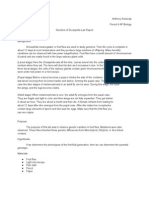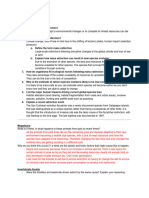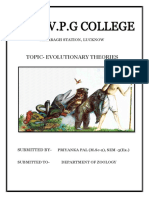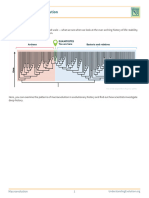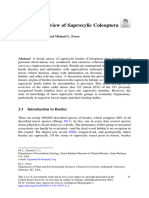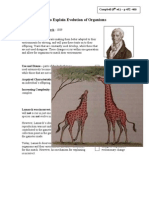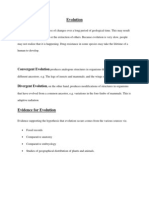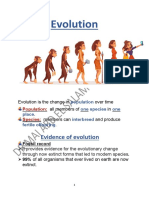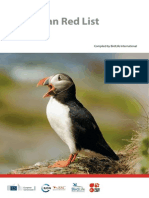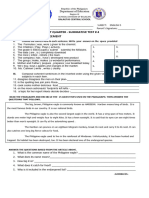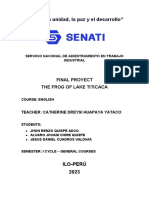Systematics and Phylogeny
Systematics and Phylogeny
Uploaded by
Bryan FabroCopyright:
Available Formats
Systematics and Phylogeny
Systematics and Phylogeny
Uploaded by
Bryan FabroOriginal Description:
Copyright
Available Formats
Share this document
Did you find this document useful?
Is this content inappropriate?
Copyright:
Available Formats
Systematics and Phylogeny
Systematics and Phylogeny
Uploaded by
Bryan FabroCopyright:
Available Formats
EXPERIMENT 2 SYSTEMATICS AND PHYLOGENY
FABRO, B. T., GUZON, M. A. F., RAMIREZ, C. L., RIVERA, M. A. Department of Biology, College of Science, University of the Philippines Baguio November 27, 2013 ABSTRACT Students create a taxonomic classification and phylogenetic tree for Caminalcules that shows the principles of classification and some processes of evolution to display the evolutionary relationships between organisms. Caminalcules diverged from a common ancestor causing variations in characters. As time goes by, some characters are developed while others are reduced. Different factors are considered in the increase and decrease of probability of organisms to be extinct.
INTRODUCTION In the study of biology, scientists or researchers often categorize things in the right order using diagrams, sketches and other illustrations. Some characteristics are observed and are used to put them in their right category. And a case in point, in which classification occurs, would be the study of the course of evolution. The construction of phylogenetic trees helps in the further understanding of how organisms changed or developed in order to survive under certain changes over time. The laboratory activity thus aimed to illustrate the principles of classification and some of the processes of evolution, and help in learning how to use the phylogenetic tree to show the evolutionary relationship between organisms. MATERIALS AND METHODS Materials: -several pair of scissors -Manila paper -Glue
-Pentel pen -meter stick -lab manual (Caminalcules) Methods: We planned the method of plotting the phylogenetic tree; we tried both methods, to plot the evolutionary tree by taking steps back, by starting at living Caminalcules, or by starting the tree by taking steps forward on evolution, and start with the simplest organism. We decided it would be easier to start from the most basic organism, since we can work with a smaller number of species. The evolutionary tree was then drafted into a piece of paper where it was checked and verified. Then twenty lines were drawn to the manila paper, representing a million years per line, starting from 19 MYA to present, 0. The Caminalcules were then cut and then glued on the manila paper, starting with the most basic, to the most evolved organism. Evolutionary lines to connect ancestors, and their descendants were drawn, completing the Phylogenetic tree.
A hierarchical classification of living caminalcules was then created using both visual data, and from the Phylogenetic tree. Grouping the organsims into their respective order, family, genus, and species.
RESULTS AND DISCUSSION This activity focuses on gaining knowledge on systematics and phylogeny, with the use of imaginary organisms, Caminalcules. These organisms were grouped from order down to the species belonging to a certain genus.
Like all organisms, the ancestor of the living species of Caminalcules came from one ancestor, which is species 73. This species gave rise to species 74 (O1), having prominent eyes, and species 58 (O2) having no eyes. This two species would later be the ancestors of the two orders of the Caminalcules. For the order coming from species 58, one family (F4) and one genus (G6) will be derived from this and will give rise to 3 species namely species 14, 13, and 28. These species almost never acquired new characteristics; therefore they are the
Fig 1. Taxonomic Caminalcules.
classification
of
living
Fig 2. Phylogenetic tree of the living species
species that resemble the most common ancestor the most. For the order coming from species 74, three families were its descendants. The first family (F1) would only have only one genus (G1), having a long body and wing-like structures as their defining characteristics, would then give rise to species 19 and 20. The second family (F2) has a short body musculature as their defining characteristic and would then give rise to 3 genera. The first genus (G2) with only one living species, 9, has retained its short body and arms like projections. The second genus (G3) gave rise species 3 and 4 having heads with one pointed antenna and straight hands with fingers. The third genus (G4) had no antennas on their head but had long and bent hands with fingers as evident in species 22, 12 and 2. The genera G2 and G3 have their common ancestor in species 41 with spotted backs as their shared characteristic different from G1. The last family (F3) coming from O1 would give rise to one genus (G5) with a bulging back as their shared characteristic. This genus would then give rise species 16, 24 and 1 with the form of their eyes their defining characteristics. CONCLUSION With the use of the imaginary organisms Caminalcules, a taxonomic classification and phylogenetic tree were made. This was made possible by knowing if a characteristic is common among the descendants, and if these characteristics would then give to more different characteristics that would be helpful in identifying and classifying these organisms.
ANSWERS TO QUESTIONS 1. You will notice that some lineages (e.g., the descendants of species 56) branched many times and are represented by many living species. Discuss the ecological conditions that you think might result in the rapid diversification of some lineages (A real world example would be the diversification of the mammals at the beginning of the Cenozoic, right after the dinosaurs went extinct). - There may be rapid and/or numerous changes on their food, and environment, causing several evolutionary steps to occur. A good example would be the Finches on the Galapagos Islands. These Finches evolved from a single ancestor, because of their changing environmental conditions. A particular region of the island may have an abundancy of nuts, thus the finches that live on that environment needs a specialized beak for breaking open nuts. A part of the Island may have an abundance of other living organisms as food, therefore the birds need to adapt specialized beaks to easily hunt down prey. As the case for the mammals, since the extinction of the dinosaurs, a huge part of the predatory organisms were wiped out, giving the mammals a chance of propagation. They migrated to several areas of the
Earth, each possessing different environmental conditions; it may once be a hunting ground for predators, giving rise to several evolutionary variations to different organisms. 2. Some lineages (e.g. the descendants of species 58) changed very little over time. A good example of this would be living fossils like the horseshoe crab or cockroach. Again, discuss the ecological conditions that might result in this sort of long-term evolutionary stasis. - The ecological conditions that might have resulted in such longterm evolutionary stasis would be the favorable weather or state by the organisms. Weather changed over time, but it might be that the weather did not really harm the organisms. Also, the ability to reproduce and adapt still, might have been the reason why some organisms changed very little over time. 3. Some Caminalcules went extinct without leaving descendants. In the real world, what factors might increase or decrease the probability of a species going extinct? - Nature has its own way of choosing of which organisms are going to live until the present day or die and get extinct through the course of time a process known as natural selection. There are several factors in which an extinction of species happens. If an organism is large enough, they tend to produce fewer offspring at widely
spaced intervals. This means fewer offsprings and successors in many generations of time and therefore, lesser chance of survival in the ever changing world. Humans are also great threats in endangering wildlife. Humans hunt for commercial purposes like elephant tusks for ivory, crocodiles skin for leather, and baleen whales to make comb. These animals are on top of the food chain, and if they get extinct, the reverse effect is expected animals below the food chain will increase in number and thus, the equilibrium of the species population is destroyed. 4. Find two additional examples of convergent evolution among the Caminalcules. This means finding cases where two or more species have a similar characteristic that evolved independently in each lineage. The wing of bats, birds and bees is an example of convergence since the three groups did not inherit the characteristic form their common ancestor. Write your answers in complete sentences (e.g., Species x and y both have ___ but their most recent common ancestor, z, did not). List two additional real-world examples of convergent evolution (ones that we have not already talked about in class) and discuss what might have caused the convergence. - Convergent evolution is evident in species 48 and 51. They developed wing-like structures not present in their most common ancestor, species 74. In the real
world, sharks and dolphins have fusiform bodies, countershaded skin, and lived in water though they are fish and mammal, respectively. The eyes of vertebrates and cephalopod mollusks are also striking evidences of convergent evolution having eyes with aperture, lens and retina. 5a. Describe two examples of vestigial structures that you can find among the Caminalcules. These are structures that have been reduced to the point that they are virtually useless. -The inner toe of species 66 was reduced in 3 million years ago, until it was virtually useless in species 22. The elbow like projection of species 35 evolved from the outer toes of species 56. As time goes by, its inner toe grows longer and longer and the two outer toes were left by and developed like an elbow projection until species 63, where the protrusion can no longer be seen. The back patches of species 16, 24 and 1 were reduced from species 56 for 8 million years ago.
5b. Explain how vestigial structures provide clues about a species evolutionary past. Illustrate your argument with vestigial structures found in humans or other real species. -Vestigial structures were once a functional part of an organism, necessary for its survival, but since evolution decided the structure would not benefit an organism's survival, they now form, and remain as nonfunctional structures. These organs can hold the key to understanding the origins of an organism, and its various species. In humans the Plica Semilunaris, is the small fold of tissue located on the inside corner of the eye, the plica semilunari are the vestigial remnants of what are referred to as "nictitating membranes" which are most commonly found in birds, reptiles, and amphibians. This suggests that birds, reptiles, amphibians, and us, mammals, once intertwined, that we were once from the same ancestor.
REFERENCES: Gendron, R. P., (2000). The Classification & Evolution of Caminalcules. The American Biology Teacher, 62(8), 573-575 http://www.zo.utexas.edu/courses/THOC/Convergence.html http://io9.com/5829687/10-vestigial-traits-you-didnt-know-you-had http://www.nabt.org/websites/institution/File/pdfs/american_biology_teacher/2000/062-080570.pdf
You might also like
- Summarizing NF Free Think Grow GiggleDocument24 pagesSummarizing NF Free Think Grow GiggleDian Nurmala WulansariNo ratings yet
- Guide To Complying Development Under The Rural Housing CodeDocument26 pagesGuide To Complying Development Under The Rural Housing Codeandrewb2005No ratings yet
- Level 2 Unit 8 Final World ClassDocument16 pagesLevel 2 Unit 8 Final World ClassIbis VillalobosNo ratings yet
- Annotated Bibliography SinclairDocument16 pagesAnnotated Bibliography Sinclairapi-483644981No ratings yet
- Phase RuleDocument27 pagesPhase RulejaiminNo ratings yet
- Drosophila Lab ReportDocument4 pagesDrosophila Lab ReportAnthony100% (1)
- Ecological Solid Waste Management Act of 2000 RA 9Document36 pagesEcological Solid Waste Management Act of 2000 RA 9Sherwin Gil AvestruzNo ratings yet
- Jose Vs BoyonDocument5 pagesJose Vs BoyonWeng CuevillasNo ratings yet
- Systematics and PhylogeneticsDocument4 pagesSystematics and PhylogeneticslazygemNo ratings yet
- HSC Biology Blue Print of LifeDocument64 pagesHSC Biology Blue Print of LifeJeffrey Avacado LiuNo ratings yet
- Evolution LabDocument13 pagesEvolution LabCatostylusmosaicus100% (1)
- The Origin of Animal Body PlansDocument15 pagesThe Origin of Animal Body PlansDiego LoboNo ratings yet
- LAB 21 - Evolution and ClassificationDocument13 pagesLAB 21 - Evolution and ClassificationMary Vienne PascualNo ratings yet
- Caminalcule Evolution LabDocument12 pagesCaminalcule Evolution LabJimeno100% (1)
- CH5 - Lesson 16 The Process of Evolution PDFDocument5 pagesCH5 - Lesson 16 The Process of Evolution PDFgwynethNo ratings yet
- Evolution Concept NotesDocument8 pagesEvolution Concept NotesMelody DellicaNo ratings yet
- STM 008 Content NotesDocument2 pagesSTM 008 Content NotesJoey NicolasNo ratings yet
- Explain Darwin's Observations and InferencesDocument13 pagesExplain Darwin's Observations and InferencesLe Phuong LyNo ratings yet
- Cold Spring Harb Perspect Biol-2014-BurkiDocument19 pagesCold Spring Harb Perspect Biol-2014-BurkiCarmen CaballeroNo ratings yet
- Biology Notes For HSCDocument29 pagesBiology Notes For HSCquinlanyiuNo ratings yet
- PP PDFDocument30 pagesPP PDFShubham ShuklaNo ratings yet
- EVOLUTIONDocument38 pagesEVOLUTIONFrancine Althea SimundacNo ratings yet
- Camina Lcu LesDocument9 pagesCamina Lcu LesArie AdajarNo ratings yet
- Evo101 06 Macroevolution UEDocument8 pagesEvo101 06 Macroevolution UEমোনতাসির জামিল তুষারNo ratings yet
- Gimmel 2018Document78 pagesGimmel 2018Ionut MarianNo ratings yet
- Evolution - Part 1Document29 pagesEvolution - Part 1Wei Zhang100% (1)
- General Biology 2: Quarter 3 - Module 4 Evolution & HeredityDocument7 pagesGeneral Biology 2: Quarter 3 - Module 4 Evolution & HeredityCamille Castrence CaranayNo ratings yet
- Understanding Phylogenies: The DefinitionDocument7 pagesUnderstanding Phylogenies: The DefinitionShikure ChanNo ratings yet
- Discuss Five Evidence That Support Organic EvolutionDocument4 pagesDiscuss Five Evidence That Support Organic EvolutionmuxyokadanNo ratings yet
- Self-Learning Home Task (SLHT)Document13 pagesSelf-Learning Home Task (SLHT)GraceEstoleCaloNo ratings yet
- Heridity and EvulationDocument7 pagesHeridity and Evulationkrushnakadam0029No ratings yet
- Convergent EvolutionDocument6 pagesConvergent EvolutionAbdul-Raheem Okai AddyNo ratings yet
- EvolutionDocument65 pagesEvolutionJaeden AnsNo ratings yet
- Lesson 5 7 Zoology Learning ModuleDocument38 pagesLesson 5 7 Zoology Learning ModuleAnde Falcone AlbiorNo ratings yet
- Evidences of Evolution - 210520 - 115553Document7 pagesEvidences of Evolution - 210520 - 115553Christine FayeNo ratings yet
- The Theory of Biological EvolutionDocument5 pagesThe Theory of Biological Evolutiondarren.yc.ngNo ratings yet
- Evidences and Bases of EvolutionDocument21 pagesEvidences and Bases of EvolutionArlynKaren VargasNo ratings yet
- Iodiversity and VolutionDocument36 pagesIodiversity and VolutionMayden Grace Tumagan GayatgayNo ratings yet
- Evolution Study MaterialDocument37 pagesEvolution Study Materialikagengradipabe2No ratings yet
- Notes On EvolutionDocument82 pagesNotes On EvolutionFritz Ivan AlonsagayNo ratings yet
- Keanekaragaman Hewan-1Document26 pagesKeanekaragaman Hewan-1eshilNo ratings yet
- Evolution BioDocument32 pagesEvolution Biokaren milloNo ratings yet
- Blueprint of LifeDocument11 pagesBlueprint of Lifetimeflies23No ratings yet
- G10 3Q Evolution-NotesDocument2 pagesG10 3Q Evolution-NotesKurt TalisayonNo ratings yet
- Science 8 - Q4 - Week 4Document29 pagesScience 8 - Q4 - Week 4AlfielAquino100% (1)
- Evolution Reading AssignmentDocument5 pagesEvolution Reading AssignmentAlexandra GanchevaNo ratings yet
- 4-5-2021 DarwinDocument4 pages4-5-2021 DarwinHaris KhanNo ratings yet
- CH 1 ExerciseDocument11 pagesCH 1 Exercisebhagwantpathak44No ratings yet
- Animal: OrganismDocument22 pagesAnimal: OrganismWraith WrathNo ratings yet
- Ecology Yr 9Document7 pagesEcology Yr 9cassNo ratings yet
- Grade 10 - Q3 - L3Document38 pagesGrade 10 - Q3 - L3Jake Aldred CabelaNo ratings yet
- EvolutionDocument27 pagesEvolutionSalma AhmedNo ratings yet
- A - Unit B - Ecosytem & Population Change (Characteristics of Ecosystems)Document7 pagesA - Unit B - Ecosytem & Population Change (Characteristics of Ecosystems)mahnoormas17No ratings yet
- The Theory of EvolutionDocument21 pagesThe Theory of EvolutionRose Anne GalanoteNo ratings yet
- Origin of Life On Earth. Getty/Oliver BurstonDocument15 pagesOrigin of Life On Earth. Getty/Oliver BurstonRaquel Elardo AlotaNo ratings yet
- Theories of EvolutionDocument9 pagesTheories of EvolutionVince Casey Villaflor100% (1)
- Evolution Survival of The WisestDocument7 pagesEvolution Survival of The WisestCornelio PascasioNo ratings yet
- Sources of Evidence in The Study of EvolutionDocument25 pagesSources of Evidence in The Study of EvolutionSidney MendozaNo ratings yet
- EVOLUTIONDocument15 pagesEVOLUTIONKiama GitahiNo ratings yet
- Zoology ModuleDocument50 pagesZoology Moduleelmark MerilosNo ratings yet
- Theory of Descent With ModificationDocument3 pagesTheory of Descent With ModificationAmitAgarwalNo ratings yet
- The Book of Frogs: A Life-Size Guide to Six Hundred Species from Around the WorldFrom EverandThe Book of Frogs: A Life-Size Guide to Six Hundred Species from Around the WorldRating: 4 out of 5 stars4/5 (1)
- The Evolutionary World: How Adaptation Explains Everything from Seashells to CivilizationFrom EverandThe Evolutionary World: How Adaptation Explains Everything from Seashells to CivilizationRating: 3 out of 5 stars3/5 (2)
- Responsive Document - CREW: US Fish and Wildlife Service: Regarding Efforts by Wall Street Investors To Influence Agency Regulations: 7/12/2011 - A Weismann PDF FOIA Log 07-12-11Document137 pagesResponsive Document - CREW: US Fish and Wildlife Service: Regarding Efforts by Wall Street Investors To Influence Agency Regulations: 7/12/2011 - A Weismann PDF FOIA Log 07-12-11CREWNo ratings yet
- Peterson Field Guides: HawksDocument276 pagesPeterson Field Guides: HawksMomzy Moo100% (8)
- These Plants Are Beguiling and They Have A Taste For MeatDocument13 pagesThese Plants Are Beguiling and They Have A Taste For MeatNimisha PathakNo ratings yet
- Rattan Conservation Statue in CambodiaDocument2 pagesRattan Conservation Statue in CambodiaDath HimNo ratings yet
- Redlist - Birdlife PublicationDocument77 pagesRedlist - Birdlife PublicationThomasEngstNo ratings yet
- National Wildlife Day by SlidesgoDocument48 pagesNational Wildlife Day by SlidesgoCAMILLA MAJOLENo ratings yet
- KD 9Document3 pagesKD 9Fuad Punya PercetakanNo ratings yet
- Entumeni NR Background Information DocumentDocument1 pageEntumeni NR Background Information DocumentNatalie BlackmoreNo ratings yet
- Ôn Tập Tiếng Anh 12 Giữa Kì 2 - Số 1, 2Document7 pagesÔn Tập Tiếng Anh 12 Giữa Kì 2 - Số 1, 2Nga NguyễnNo ratings yet
- Elephant - WikiDocument37 pagesElephant - WikiClaudia YtusacaNo ratings yet
- L Church Black Rhino Reserve FinalDocument8 pagesL Church Black Rhino Reserve Finalapi-254577331No ratings yet
- Notice: Endangered and Threatened Species: Incidental Take Permits— Utah Utah Prairie Dog Habitat Restoration Safe Harbor AgreementDocument2 pagesNotice: Endangered and Threatened Species: Incidental Take Permits— Utah Utah Prairie Dog Habitat Restoration Safe Harbor AgreementJustia.comNo ratings yet
- Unit 2 - TDocument9 pagesUnit 2 - TSasha SashaNo ratings yet
- IBAs Peru PDFDocument11 pagesIBAs Peru PDFLuis Carlos Suna BecerraNo ratings yet
- Scarlet Macaw #188629 For Sale in Mount Solon, VADocument5 pagesScarlet Macaw #188629 For Sale in Mount Solon, VAJake JamesNo ratings yet
- Bird+List Charlapally Rampally+Cheruvu 19.09.10Document2 pagesBird+List Charlapally Rampally+Cheruvu 19.09.10Vikram PenmetsaNo ratings yet
- BiodiversityDocument40 pagesBiodiversitySimran jeet Kaur0% (1)
- ENGLISH Summative4Document2 pagesENGLISH Summative4Gina VenturinaNo ratings yet
- Avance Del Proyecto Final InglesDocument7 pagesAvance Del Proyecto Final InglesJesus Daniel Cuadros 5CNo ratings yet
- Non Volant Mammals of Binahaan River Watershed Forest ReserveDocument98 pagesNon Volant Mammals of Binahaan River Watershed Forest ReserveEarl Joseph TinamisanNo ratings yet
- Tiger NotesDocument1 pageTiger Notesmichaela.deleon07No ratings yet
- Danta de ParamoDocument5 pagesDanta de ParamoFabian SalgadoNo ratings yet
- Text 1. The History & Legends of The Scottish ThistleDocument2 pagesText 1. The History & Legends of The Scottish ThistleMarioLABrieNo ratings yet
- Camouflage FinalDocument9 pagesCamouflage Finalapi-238841101No ratings yet
- The Philippine EagleDocument6 pagesThe Philippine EagleSaurabh AhujaNo ratings yet
- De Thi Chuyen AnhDocument15 pagesDe Thi Chuyen AnhDinhtho Tran100% (1)





